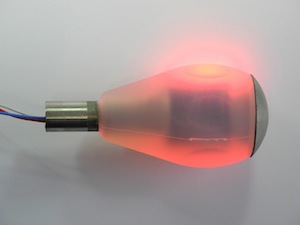
The smart handle from Fraunhofer.
Surgeons learn to conduct all sorts of mind-bogglingly complex procedures within our bodies, whether it's installing and adjusting medical devices, removing or ablating tumors, or conducting precise surgery on organs as small as our eyes. Surgeons do incredible work with their hands and manual tools, but a new generation of smart surgical tools, incorporating microsensors and instant feedback, could make these difficult jobs safer and easier.
The latest such tool, from Fraunhofer Institute for Manufacturing Engineering and Automation IPA and Weber Instrumente GmbH in Stuttgart, Germany, which, as MedGadget noted, is similar to the digital torque wrench a mechanic might use to fix your car. It's actually a smart handle that can be attached to surgical screwdrivers or surgical spreaders. Sensors in the handle measure the force being applied and tell the surgeon whether they can safely tighten a screw more or insert a tool more deeply -- specifically, the handle lights up when it reaches optimal torsion.
It's more complicated to make a smart surgical device than, for instance, a mechanic's wrench, because surgical tools need to be sterile. There can't be any seam or hole where germs can fester, and the whole device needs to be able to be sterilized. Fraunhofer's handle charges wirelessly with no plug and the electronics can be switched off so the device can be safely heated up to 134 degrees Celsius. The handle also records the force data and can transmit it to a computer, allowing the surgical process to be documented for research or training.
Another technology, developed this past summer at Johns Hopkins, was designed to aid surgeons in operations involving very small movements - like eye surgery.
"The retina is about 250 microns thick and very fragile," Kristi Birch writes in the Johns Hopkins Engineering Magazine. "Some scar tissue is no more than 3 microns thick and transparent to boot. And when even a good eye surgeon can have 40 microns of hand tremor that must be compensated for, removing the scar tissue is very difficult and not always successful. Surgeons sometimes have had to accept small areas of injury in order to recover larger or more vision-critical areas of the retina."
Like the smart handle, the tool developed by Jin Kang is a module that can be attached to different surgical tool tips. Using a laser probe and a motor, the tool compensates for a surgeons involuntary hand movements, holding the tool steady even during extremely precise surgery.
One more technology moves beyond tools as we know them entirely, making the surgeon's hand itself into a smart device. As reported in the Daily Mail, electronic fingertip sensors developed by researchers from University of Illinois at Urbana-Champaign, Northwestern University and Dalian University of Technology can be built into surgical gloves, allowing surgeons to detect data like temperature and connectivity. The gloves could allow surgeons to perform heat-based ablation from their fingertips or even obtain ultrasound imagery of the tissue. The gloves were written up in the journal Nanotechnology last August.















